
|

|
My life in Art, Part I
This accounting of one of the sport's most visible artists is provided by the artist himself, John Prince, along with his art, which continues to diversify and evolve.
Part One, art and words by John Prince
Layout by Reuben Edwards
|
|
|

|
| I’ve always drawn and made things. Here's a photo of a 14-year-old John Prince from the Hutt Valley High School photo records about the time I discovered croquet.
|
The John Prince three-part memoir is one of the most popular articles ever done in this magazine. John and the editor have long planned to do a multi-part story focused on croquet, and this is it. Many top-ranked players find other pursuits to follow once they determine that their competing days are over. (Wayne Rodoni put it this way: "Why should I compete? I've already won everything I was going to win. Now all I could do is lose.") Many of us have a version of the same story, beginning locally when all you had to do was pick up a mallet to be nationally ranked. Fortunately for John--and for us--his art was waiting for him when he quit competing. John comments personally on all the art in this story.

|
As a teenager I copied this pencil drawing from a Michelangelo painting or sculpture. The art I took as a subject at school included painting, book illustration and calligraphy (Roman Lettering). I passed the school certificate examination on my second attempt. (I wasn’t a diligent student!) I remember the painting teacher sweeping past me often saying “Too dark too soon!" Some 40 years later I received a New Zealand Business studies Diploma in cartooning and illustration. My tutor said my work reminded him of Norman Thelwell, a British cartoonist who made delightful cartoons of chubby grumpy ponies and their equally determined young riders.
"Drawing from Michelangelo" [better view]
|
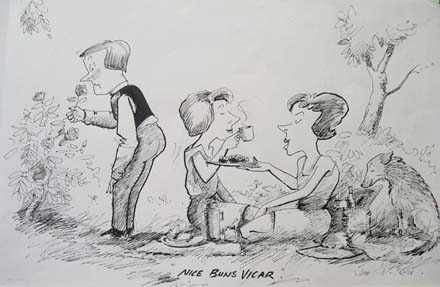
|
"Nice buns Vicar" is a pen drawing that was part of my Diploma portfolio.
"Nice buns Vicar" [better view]
|
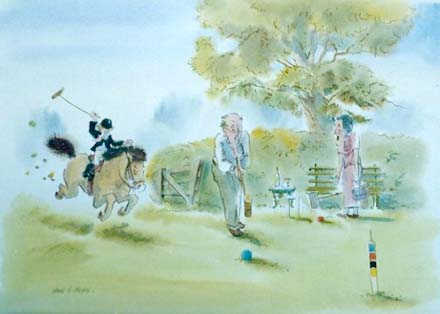
|
"Look out George" is a watercolour homage to Thelwell.
""Look out George"" [better view]
|
During the 1990’s I produced a number of pen drawings for Croquet New Zealand publications including the three part “Approaching Croquet” coaching booklets, and a Calendar in 1993 and 1994 with the proceeds from the latter supporting the CNZ Arthur Ross Memorial nationwide association
croquet handicaps singles tournament.
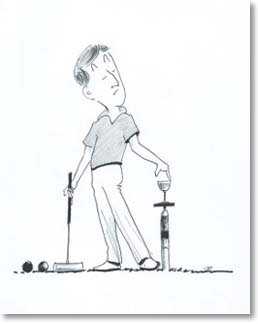
|
"A handy and useful replacement for the peg extension". In my first few playing seasons I played a number of games during weekends with Monty Reitchesen at Waimarie Croquet club. Reitchsen was the Director of Parks and Reserves for the Lower Hutt City Council, so the club had the luxury of a full time Groundsman who maintained the four courts and surrounding flower gardens to a very high standard. Monty told me about playing a tournament in Ireland where they had an attachment for the peg so you could have a sip of your favourite tipple each time you went to the pivot ball while making a 4 ball break.
"A handy and useful replacement for the peg extension; [better view]
|
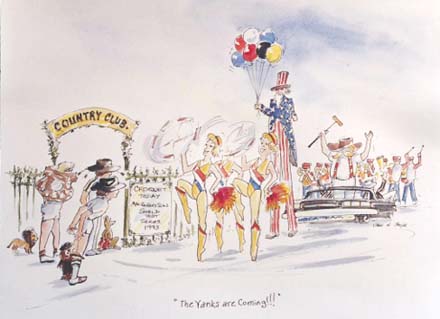
|
"The Yanks are coming." In 1993 the USA took part in the MacRobertson Shield International Test Series at Rich River in Australia. We just had to have a cartoon in the Calendar to mark that special occasion.
"The Yanks are coming; [better view]
|

|
"Croquet through the ages in England." In 1996 my good friend John Solomon, president of the Croquet Association, contacted me about a centenary of some sort coming up and they thought of having plaques or plates made to acknowledge the event. I made a design in watercolour showing croquet through the ages at Wimbledon, Roehampton and Hurlingham. As it turned out they didn’t proceed with the idea. I loaned the artwork to Croquet New Zealand, but it seems to have now disappeared.
"Croquet through the ages in England" [better view]
|
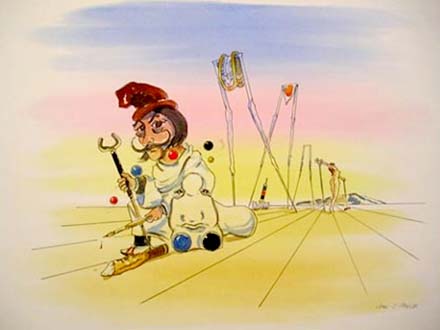
|
"Dali plays Croquet." A watercolour imagines how Dali may have seen croquet using a number of his symbols. As a youngster I delighted in discovering books in the local library about Dali, Delacroix and Bernard Buffet.
"Dali plays Croquet" [better view]
|
Further inspiration came from books by England’s John Blockley, another artist who painted rural subjects in watercolour, breaking all the traditional rules around watercolour by combining Indian ink in his paintings, then washing part of it off, drawing into watercolour with a pen or stick intending to capture the atmosphere of his subjects. "The Challenge of Watercolour" was the first of his books I purchased. His descriptions about each piece were unique, things like, "I added a little cadmium red, although there was no red there."
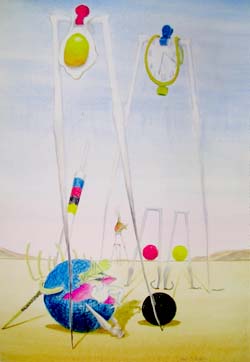
|
"Birth of the Exquisite Croquet Player" uses Dali’s symbols, his face formed by the red and yellow balls (eyes), black ball (mouth) and two worms emerging from the hoop holes as his famous moustache.
"Birth of the Exquisite Croquet Player" [better view]
|
| "Escher discovers Croquet" continues the famous artists theme in acrylic on canvas.
"Escher discovers Croquet; [better view]
|

|
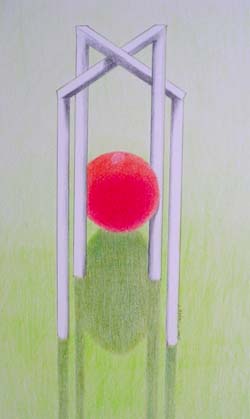
|
"Entering Escher’s croquet cage (or basket)." I had a lot of fun working this coloured pencil one out.
"Entering Escher’s croquet cage (or basket)" [better view]
|
| In "Magritte discovers croquet at the seaside" by sheer chance a face emerged formed by the shoes, wine glass base, and blue ball.
"Magritte discovers croquet at the seaside" [better view]
|
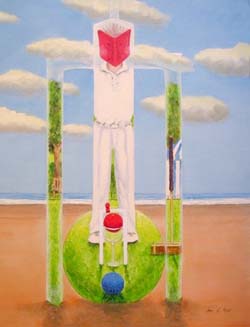
|

|
| I’m most grateful to those who have purchased my artwork over the years. It has enabled me to take part in international croquet competitions without putting too much strain on family finances, as my wife Sue had two young boys to look after when I was away. This acrylic, "The Croquet Match," I gave to the Canterbury Croquet Association to auction at the dinner at the conclusion of the 2008 World Championships. Some lively bidding resulted in a good return, very likely to remain the highest price ever paid for a work of mine.
"The Croquet Match" [better view]
|
The 1969 CNZ Best Eight was played at the Blenheim Croquet club. During the tournament my good friend Gordon Rowling asked me if I’d like to come with him and see some paintings by local painter Robert Chilvers. Gordon had bought some of Chilver’s landscape work depicting views of Golden Bay, Motueka, an area he knew very well. Robert showed us some monochrome layouts painted on site that he would finish later in colour in the studio.
Seeing later the finished paintings in a Wellington Gallery inspired me to have a go at some serious painting. When living in Hastings in the 1970/80’s I discovered the artwork of American painter Andrew Wyeth in a library book. He painted a world I knew from school days going on holiday on relatives farms.

|
| "Wood’s Farm." This acrylic on wood panel was painted many years after I stayed there as a small boy and lead a calf around the Grand Parade at Agricultural and Pastoral shows.
"Wood’s Farm" [better view]
|
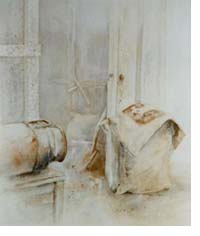 "O'Neill’s Hen House." I discovered a little old cottage down the far end of our road in Hastings, a fascinating rural subject owned by an elderly chap who lived there all his life. Martin O’Neill’s became a major source of subjects for me. I made drawings on site and later when everyone had gone to bed made watercolours from the drawings, sometimes working well into the early hours.
"O'Neill’s Hen House." I discovered a little old cottage down the far end of our road in Hastings, a fascinating rural subject owned by an elderly chap who lived there all his life. Martin O’Neill’s became a major source of subjects for me. I made drawings on site and later when everyone had gone to bed made watercolours from the drawings, sometimes working well into the early hours.
"O'Neill’s Hen House" [better view]
|
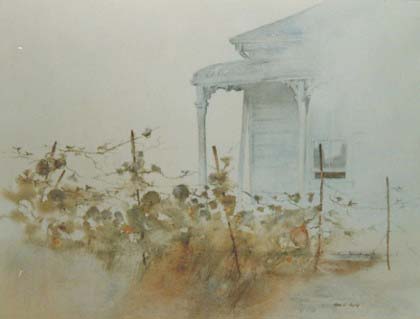
|
| "O'Neill's Pumpkin Patch." In the front yard, where most people have a lawn, Martin grew pumpkins. Around the back lived a number of hens, ducks and geese alongside old farm machinery, and across the paddock an old cowshed, all great subjects.
"O'Neill's Pumpkin Patch" [better view]
|
| "The Orion Coal Range." After I got to know Martin I asked if I could make some drawings inside. He looked a little alarmed and said "I'd need to tidy up a bit. " I immediately replied "No Martin, just leave everything as it is, please", "Oh that's alright then" he said with a look of relief.
"The Orion Coal Range" [better view]
|
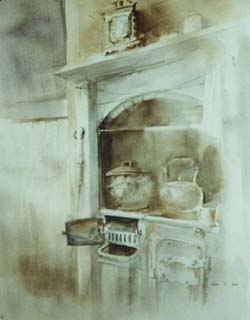
|
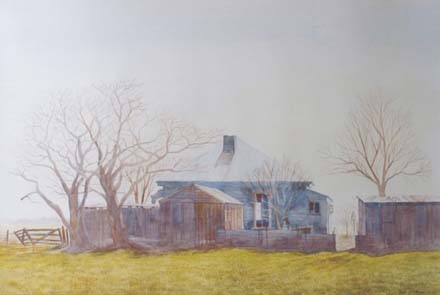
|
| "High Noon at O'Neill's" was painted much later in watercolour from drawings after we had moved to Christchurch.
"High Noon at O'Neill's" [better view]
|
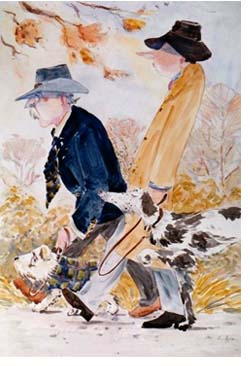 "A Walk in the Park." In the late 80's we moved to Christchurch for my employment. I'd always fancied living in the South Island, having played tournament croquet down south. I joined the famous United Croquet Club in Hagley Park where I saw a group of about 20 people walking Irish Wolfhounds past the lawns one sunny morning.
"A Walk in the Park." In the late 80's we moved to Christchurch for my employment. I'd always fancied living in the South Island, having played tournament croquet down south. I joined the famous United Croquet Club in Hagley Park where I saw a group of about 20 people walking Irish Wolfhounds past the lawns one sunny morning.
I then hit on the idea of making some art with people and their dogs who had features or apparel that was somewhat similar. A few years later I came across the delightful artwork of David Eustace, who did dogs and their owners in the Pub. (Dogs are of course welcome in most Pubs in England. After all. they are very likely far better behaved than some of the human patrons.)
"A Walk in the Park" [better view]
|
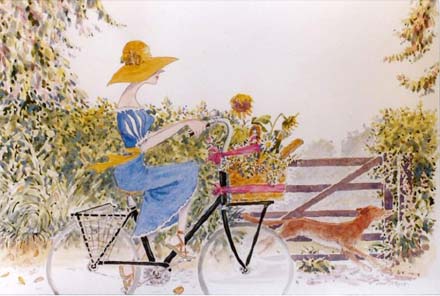
|
| "Off for a picnic" is another watercolour in a similar vein.
"Off for a picnic" [better view]
|
| "The Croquet Challenge" is an imaginary painting in watercolour and permanent art markers. There was a ball carrier like this one at my first club, NaeNae, very elegant, but there was nowhere for the penny coin, used to toss for starting, to go.
"The Croquet Challenge" [better view]
|
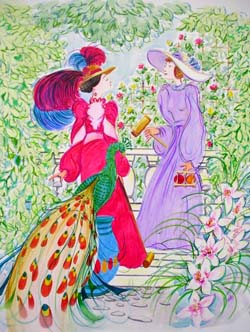
|
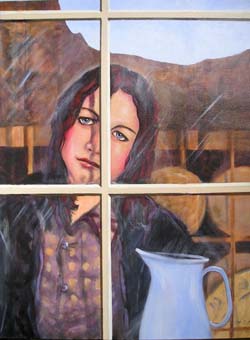
|
"Lost inside" is a large acrylic inspired by the amazing UK TV series "Sparkhouse," written by the equally amazing Sally Wainwright. With echoes of "Wuthering Heights," the genders are reversed: Heathcliffe is Carol and Cathy is Andrew. It is a modern day powerful story of secrets, abuse, betrayal, loss and undying love.
"Lost inside" [better view]
|
| "Venetian Mask." I purchased the blank white Joker mask two years ago in Venice and added the decoration, cord, bells and paintwork when I got back home.
"Venetian Mask"
[better view]
|
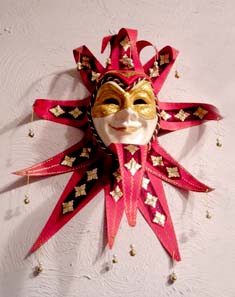
|
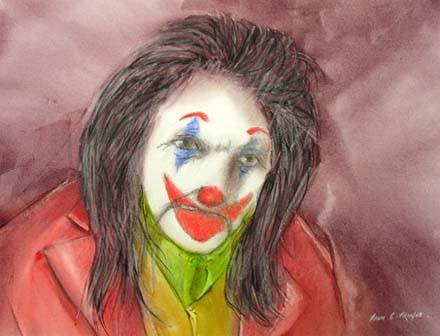
|
| "The Joker." I enjoyed Joaquin Phoenix's performance in the recent movie of that name. So I got my trusty model. who holds a pose with ease, is always available and never asks for any money. He did, however, refuse to paint his face and tongue white.
"The Joker" [better view]
|
PART TWO is coming soon!
John Prince and his wife Sue live in Central Hawkes Bay. He is a member of the Rangatira Croquet club in Dannevirke. In 1999 he was made a Member of the New Zealand Order of Merit for his services to Croquet. He is a Life Member of Croquet New Zealand, Canterbury Croquet Association, and United Croquet Club, an Honorary Overseas Life Member of the English Croquet Association and listed in the Halls of Fame of the World Croquet Federation and Croquet New Zealand.
|
|

















 "O'Neill’s Hen House." I discovered a little old cottage down the far end of our road in Hastings, a fascinating rural subject owned by an elderly chap who lived there all his life. Martin O’Neill’s became a major source of subjects for me. I made drawings on site and later when everyone had gone to bed made watercolours from the drawings, sometimes working well into the early hours.
"O'Neill’s Hen House." I discovered a little old cottage down the far end of our road in Hastings, a fascinating rural subject owned by an elderly chap who lived there all his life. Martin O’Neill’s became a major source of subjects for me. I made drawings on site and later when everyone had gone to bed made watercolours from the drawings, sometimes working well into the early hours.



 "A Walk in the Park." In the late 80's we moved to Christchurch for my employment. I'd always fancied living in the South Island, having played tournament croquet down south. I joined the famous United Croquet Club in Hagley Park where I saw a group of about 20 people walking Irish Wolfhounds past the lawns one sunny morning.
"A Walk in the Park." In the late 80's we moved to Christchurch for my employment. I'd always fancied living in the South Island, having played tournament croquet down south. I joined the famous United Croquet Club in Hagley Park where I saw a group of about 20 people walking Irish Wolfhounds past the lawns one sunny morning.




